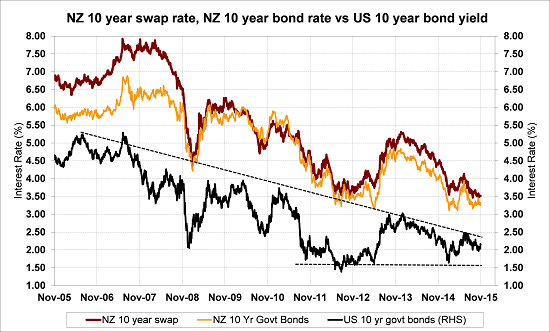
By Roger J Kerr

A few more positive economic news stories (like the dramatic improvement in the business confidence index last week) will be making the RBNZ’s decision making on monetary policy settings even more difficult than it usually is.
Whilst the fraternity of NZ economists seem to think that a fourth OCR cut to 2.5% is a “lay down misère” on 10 December, the money markets are 50/50 on their forward pricing (not pricing a full 0.25% cut until March) and the FX markets seem to be pricing the NZ dollar higher (i.e. no OCR cut).
Take your choice on who may be right. However I always back the financial markets over the economists!
From where I sit, wholemilk powder dairy prices (currently US$2,700/MT) would need to reverse and plummet back down below US$2,000/MT for the RBNZ to be confident enough to cut by 0.25% in early December.
The other pre-condition for an OCR cut would be a much higher NZD/USD exchange rate over 0.7200 meaning that annual inflation stays below 1.00% for much longer.
It is impossible to see those two scenarios happening at the same time.
Further monetary loosening is always “conditional on the data” and I expect to see continuing strong economic data over the next month that should rule out any OCR cut.
Long term interest rate trends suggest another market crunch point coming up in front of us.
US 10-year Treasury Bond yields have moved up from 2.00% to 2.15% over the last week following the more clear-cut guidance from the Federal Reserve on the timing of their first increases in short-term interest rates in 10 years.
An increase in the Treasury Bond yields to above 2.40% would break above the downward sloping trend-line (see chart below) that these interest rates have remained below for a very long time.
Corporate borrowers in New Zealand who have not taken advantage of the opportunity of this latest dip in long-term interest rates to secure fixed rate borrowing for 10 years plus should be re-examining their strategies. The debt component of the weighted-average cost of capital may never be lower!

To subscribe to our daily Currency Rate Sheet email, enter your email address here.
Daily swap rates
Select chart tabs
Roger J Kerr is a partner at PwC. He specialises in fixed interest securities and is a commentator on economics and markets. More commentary and useful information on fixed interest investing can be found at rogeradvice.com
1 Comments
An increase in the Treasury Bond (sic) yields to above 2.40% would break above the downward sloping trend-line (see chart below) that these interest rates have remained below for a very long time.
A bigger concern is the unvisited reality that swap yields trade below on-the-run UST yields.
It is notable that the 5-year spread is now negative alongside 7s, 10s and 30s. The 2-year spread, after trading sideways upon the last FOMC non-action in September, has now broke below 10 bps and seems heading (as of this moment) toward the mythical zero lower bound. This coordinated compression in spreads, especially those getting and already negative, is nothing but a financial warning of dark leverage removal upon eurodollar “supply.” Read more

We welcome your comments below. If you are not already registered, please register to comment.
Remember we welcome robust, respectful and insightful debate. We don't welcome abusive or defamatory comments and will de-register those repeatedly making such comments. Our current comment policy is here.